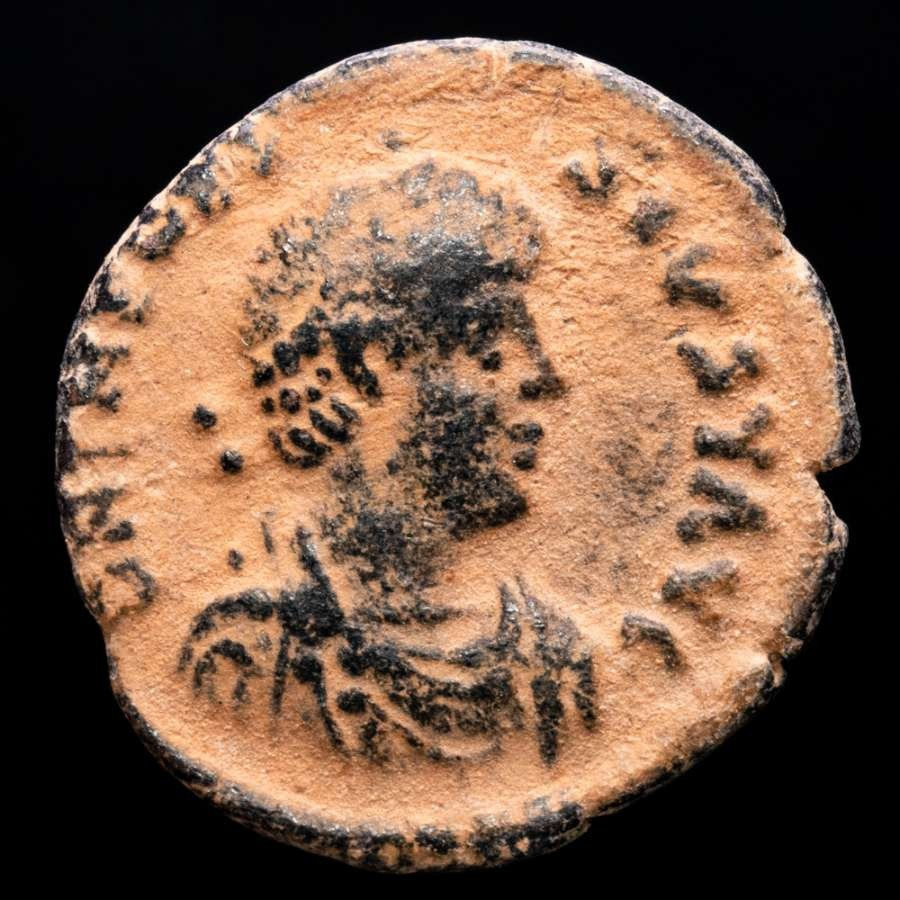The Tale of Theodosius I and the Æ Follis
Step back into the late 4th century AD, a period of significant transformation within the Roman Empire. The bustling streets of Antioch, one of the great cities of the Eastern Roman Empire, are filled with the vibrant sounds of commerce and daily life. Among the many coins in circulation is the Æ Follis—this particular coin features Theodosius I, symbolizing his efforts to unify and stabilize the empire.
Meet Theodosius I:
Imagine Theodosius I, also known as Theodosius the Great, who ruled from 379 to 395 AD. His reign was marked by his efforts to strengthen the Roman Empire, enforce orthodox Christianity, and manage the challenges of a vast and diverse realm. His coin, minted in Antioch, carries significant historical and cultural weight, celebrating his achievements and his role as a unifier of the empire.
The Coin's Journey:
Hold the coin in your hand—18 millimeters of solid bronze, weighing 2.22 grams, yet resonating with the legacy of a powerful empire. On the obverse, the legend "DN TEODOSIVS PF AVG" frames the pearl-diademed, draped, and cuirassed bust of Theodosius I, facing right. This imagery emphasizes his imperial authority and divine favor.
Flip the coin to reveal its reverse, where the legend "CONCORDIA AVGGG" (Harmony of the Emperors) is inscribed. The scene depicted shows Constantinopolis, helmeted and enthroned facing, head turned right, holding a spear and globe, with her right foot resting on a prow. This imagery underscores the emperor’s role in ensuring harmony and stability within the empire.
The Grandeur of Antioch:
Picture the coin’s journey through the bustling marketplaces of Antioch. It pays for various goods—fresh bread, wine, or perhaps a finely crafted piece of pottery. Each transaction weaves a thread into the rich tapestry of Roman life, connecting the people to their emperor and his efforts to maintain unity and prosperity.
A Time of Unity and Reform:
Theodosius I’s reign was marked by significant efforts to unify the Roman Empire under orthodox Christianity and to reform the administrative and military structures of the state. The issuance of coins like this one commemorated his achievements and reinforced his image as a stabilizing and unifying force.
Historical Context:
Theodosius I:
Theodosius I was a Roman Emperor who ruled from 379 to 395 AD. He is best known for making Christianity the state religion of the Roman Empire and for his efforts to maintain the unity of the empire during a time of internal and external challenges. His reign saw the final defeat of paganism as a state-sponsored religion and the establishment of the Nicene Creed as the standard of Christian orthodoxy.
Symbolism and Propaganda:
Obverse Imagery:
The pearl-diademed, draped, and cuirassed bust of Theodosius I symbolizes his divine right to rule and his role as a military commander. The diadem signifies his imperial authority, and the cuirass represents his readiness to defend the empire.
Reverse Imagery:
The reverse of the coin features Constantinopolis, symbolizing the city of Constantinople, the new capital of the Roman Empire. The enthroned figure holding a spear and globe represents the city's power and influence. The foot resting on the prow signifies naval power and the control of maritime routes, essential for the empire’s stability and prosperity. The legend "CONCORDIA AVGGG" highlights the harmony and unity under Theodosius’s reign.
Social Story and Usage:
Society During Theodosius I’s Reign:
Theodosius I’s reign was a time of significant transformation for the Roman Empire. The spread of Christianity, the establishment of Constantinople as a central power, and various administrative reforms marked his rule. Despite these changes, the economy and daily life continued, with coins like this one playing a crucial role in facilitating commerce and propagating the emperor’s image and virtues.
The Æ Follis of Theodosius I minted in Antioch is a valuable artifact from a critical period in Roman history. The coin's design, with its potent symbols and legends, served not only as a medium of exchange but also as a tool of imperial propaganda, reinforcing Theodosius I’s image as a pious, victorious, and benevolent ruler. Understanding the context and significance of such coins provides valuable insights into the political, economic, and social dynamics of the Roman Empire during the late 4th century.
Theodosius I (379-395 CE)
Opening Sale
- Authority: Theodosius I
- Dynasty: Theodosian Dynasty
- State: Roman Empire
- Metal: Bronze
- Mint: Antioch
- Denomination: Æ Follis
- Date: 378-383 AD
- Weight: 2.22 grams
- Diameter: 18 mm
- Condition: gVF (Good Very Fine) with a nice original desert orange (sand) patina
- Reference: RIC 46
Obverse:
- Legend: "DN TEODOSIVS PF AVG" (Dominus Noster Theodosius Pius Felix Augustus)
- This emphasizes his status as emperor and his divine favor.
- Type: Pearl-diademed, draped, and cuirassed bust of Theodosius I facing right.
- Portrait: Theodosius I
Reverse:
- Legend: "CONCORDIA AVGGG" (Harmony of the Emperors)
- This legend signifies the unity and stability brought by the emperor’s rule.
- Type: Constantinopolis, helmeted and enthroned facing, head turned right, holding a spear and globe, with right foot resting on a prow.
- MintMark: ANTΓ (indicating the mint of Antioch)

